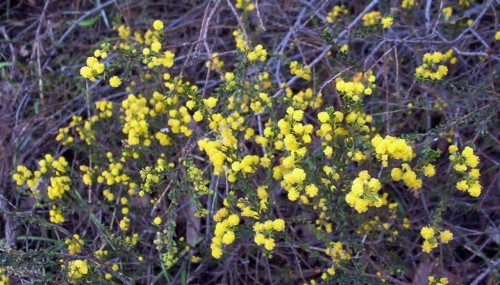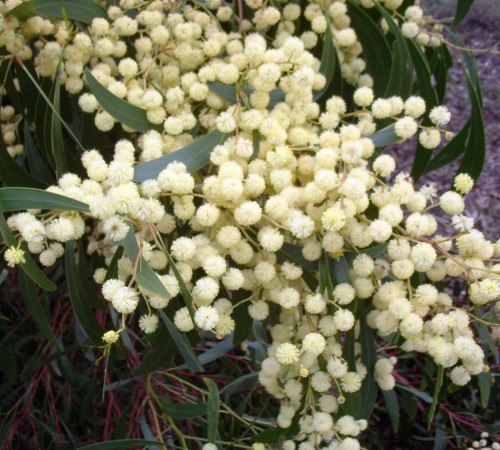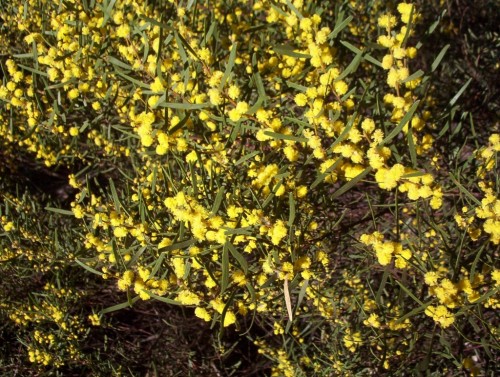Acacia rhetinocarpa
Acacia rhetinocarpa is a rare wattle which is endangered in South Australia. I have a plant given to me many years ago. Every year I miss out on the seed as the pods seem to split quickly and seed has gone before I get a chance to collect them. Seeing the abundance of the flowers this year hopefully means that seed will set and if I am organised I will try to put a stocking bag over a few branchlets to catch the seed.It is a pretty ornamental wattle.
Members of the local Australian Plant Society used to check on a small colony of plants near here. The plants grew in a position where they received some water run-off from the road. Ferries McDonald Conservation Park in South Australia has some colonies which were protected by the Field Naturalists Society.
My plant is only about a metre tall and wide. They can get to one and a half metres but mine is growing at the base of some mallee trees and has root competition.This is another tough drought, frost and lime tolerant plant.
Acacia pycnantha (Golden Wattle)
These are making a great splash of colour around the country side now. We have a couple and when the seed pods set and seed is ripening, the galahs have a great feed from them. Unfortunately it does not deter them from the almond trees. One day I would like to have just one feed from the tree, instead of these freeloaders getting the lot.
However I have found a few trees that have cream flowers rather than the golden yellow balls. The trees still seem to have the same form, although here they don’t grow as tall as they might in a higher rainfall area. In a good season we do get seed germinating near the parent tree. This winter has been so dry that it won’t happen this year.
In general Acacias make great plants for windbreaks. Those trees that get artificail watering from, say, a sprinkler on a lawn, don’t seem to live as long as those in the bush.
Acacia wilhelmmiana
ITWhiz Son is messing around with the layout of my blog. I like the photo grouping across the top but may get him to put a couple of different ones on that better reflect the types of plants that I like to propagate.
The warm wind today will finish off the wattles here I think. Acacia notabilis (Notable Wattle) had a few isolated golden balls as opposed to the masses of flowers in previous years. Acacia wilhelmiana was looking quite good but is going ‘off’ now.
This grows along the roadsides here. They are a wide shrub, perhaps 3-4m by about 2m tall. They create a hedge like effect and would be great for that hedge or screening effect, especially in wind break plantings. As always, drought tolerant, frost hardy and lime tolerant.
Many people complain that wattles cause allergic reactions etc yet it is denied that these are the culprits. Many grasses cause hayfever and most flower when the wattles are also in flower.
I love the cheery colours as they begin flowering when it is still dull and grey here.
Propagating Acacias (Wattles)
Acacias are generally propagated from seed. Seed can be bought from native seed merchants and it stores well if you collect your own. I have lost some seed to weavils which disgusted me when I opened the bag of seed to find piles of ‘crumbs’ and some very well fed weavils.
Acacia seed has a very hard seed coat. I found it easier to use nail clippers to nick the side of the seed. This needs some dexterity to hold the seed between the fingers of one hand in such a position that the nippers of the nail clippers can actually get at the side of the seed!
However I have had 100% germination from seed that was actually large enough to do this.
Smaller seed I find easiest to abraid gently between two pieces of sand paper. Place one piece of sand paper on a board, the seed on that and use the other piece of sand paper, rough side against the seeds and twist the sand paper back and forth 3 0r 4 times. The seed casing can be seen to be thinner. I have found that too much pressure wrecks the seed like a grinding stone.
Seed is sown and covered to about the depth of the seed. I also use a thin layer of small washed gravel on top of this to prevent the seed from being washed out and to act as a mulch. Seed is best sown in autumn or spring. I had good germination in June this year but was actually saved by the fact that we had no rain.
Some Acacias can be propagated from cuttings. Firm new seasons growth is used.
Growing Acacias (Wattles)
Acacia is the largest genus in Australia with over 700 named species. They make excellent garden plants and it is possible to have at least one flowering through out the year if selected carefully for the growing conditions.
The leaves are not true leaves and are known as phyllodes. Many Acacias have very prickly or sharp pointed phyllodes, a fact that needs consideration when choosing species to grow. A prickly plant, regardless of the beauty of the plant in flower, is a pain (literally) if planted where one opens the door of the car and has to brush past it.
However to control foot traffic and for security, these have their uses. Small birds also appreciate the security of these prickly plants for nesting sites.
All Acacias are useful for erosion control. They respond well to pruning after flowering and this can extend the life of the plant. Wattles are very fast growing and can flower in the second year after germination.
The main pests are borers. These can be controlled by manually probing the hole with a piece of wirer or using a weak insecticide squirted into the hole. Some plants have galls and these are hard to control.
Research has shown that some species are sensitive to phosphorus in the soil and there is a need to take care with fertilisers. As a general rule a slow release fertiliser suitable for Native plants is safest. Symptoms of sensitivity are browning of the edges and dropping of the older leaves.
A good source of pollen, Wattles are popular with apiarist. The seeds are also an important source of food for birds. The seeds of Acacia calamifolia are part of the diet of the endangered Mallee Fowl. Some other species of Wattle are part of the Bush Tucker industry, particularly Acacia victoriae. As the seeds of some species are actually toxic, one needs to be sure of the identity of a species!


